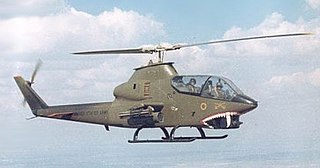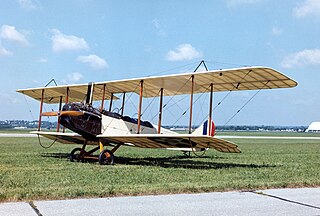
The Bell AH-1 Cobra is a single-engined attack helicopter developed and manufactured by the American rotorcraft manufacturer Bell Helicopter. A member of the prolific Huey family, the AH-1 is also referred to as the HueyCobra or Snake.

The Bell UH-1 Iroquois is a utility military helicopter designed and produced by the American aerospace company Bell Helicopter. It is the first member of the prolific Huey family, as well as the first turbine-powered helicopter in service with the United States military.

The Grumman OV-1 Mohawk is an American armed military observation and attack aircraft that was designed for battlefield surveillance and light strike capabilities. It has a twin turboprop configuration, and carries two crew members in side-by-side seating. The Mohawk was intended to operate from short, unimproved runways in support of United States Army maneuver forces.

The Fargo Air Museum is an aviation related museum in Fargo, North Dakota. It is located at Hector International Airport in the northern part of the city. The museum includes many historic aircraft of which 90% are in flying condition.

The Olympic Flight Museum is an aviation museum at the Olympia Airport in Olympia, Washington, USA. The museum has more than 10 vintage planes and helicopters on display, most of which are in airworthy condition. The museum also hosts the annual Olympic Air Show, featuring a selection of heritage and current military aircraft demonstrations.

The Aeronca L-3 group of observation and liaison aircraft were used by the United States Army Air Corps in World War II. The L-3 series were adapted from Aeronca's pre-war Tandem Trainer and Chief models.

The Travel Air 6000 is a six-seat utility aircraft manufactured in the United States in the late 1920s.

The Grissom Air Museum is a military aviation museum at Grissom Air Reserve Base near Peru, Indiana with over twenty aircraft on display.

The United States Army Aviation Museum is an aviation museum located on Fort Novosel near Daleville, Alabama. It has the largest collection of helicopters held by a museum in the world. The museum features some 50 aircraft on public display with aviation artifacts ranging from a replica of the Wright brothers' Model B military biplane to an AH-64 Apache from Operation Desert Storm. The museum has over 160 aircraft in its collection and holds 3,000 historical items.

The Standard J is a two-seat basic trainer two-bay biplane produced in the United States from 1916 to 1918, powered by a four-cylinder inline Hall-Scott A-7a engine. It was constructed from wood with wire bracing and fabric covering. The J-1 was built as a stopgap to supplement the Curtiss JN-4 in production.

The Alaska Aviation Museum, previously the Alaska Aviation Heritage Museum, is located on Lake Hood Seaplane Base in Anchorage, Alaska. Its mission since 1988, is to preserve, display, and honor Alaska's aviation heritage, by preserving and displaying historic aircraft, artifacts, and memorabilia, and to foster public interest in aviation and its history. The museum has over thirty aircraft on display, a restoration hangar, flight simulators, two theaters, and a Hall of Fame. It provides an emphasis on historic aircraft, aviation artifacts, and memorabilia that contributed to the development and progress of aviation in Alaska, including Bush flying, and the World War II Army base on Adak Island.

The Bell Huey family of helicopters includes a wide range of civil and military aircraft produced since 1956 by Bell Helicopter. This H-1 family of aircraft includes the utility UH-1 Iroquois and the derivative AH-1 Cobra attack helicopter series and ranges from the XH-40 prototype, first flown in October 1956 to the 21st-century UH-1Y Venom and AH-1Z Viper.

The Bell H-13 Sioux is an American single-engine light helicopter built by Bell Helicopter and manufactured by Westland Aircraft under license for the British military as the Sioux AH.1 and HT.2.

Classic Rotors is a flying aviation museum specializing in helicopters and other rotorcraft, located at the Ramona Airport in Ramona, California, United States.
On January 17, 2018, a Bell UH-1H Iroquois helicopter of Sapphire Aviation crashed near Raton, New Mexico, United States. Five of the six people on board were killed. The sole survivor was in serious condition.
The Mid America Flight Museum is an aviation museum located at the Mount Pleasant Regional Airport in Mount Pleasant, Texas.














